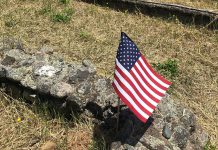
“One if by land, two if by sea.” Henry Wadsworth Longfellow immortalized Paul Revere’s ride for freedom, which took place 250 years ago, on April 18, 1775. Revere’s mission was to alert Samuel Adams and John Hancock that British troops were coming to Lexington and Concord to destroy military supplies.
The British came indeed, and the first shots were fired at North Bridge in Concord, Massachusetts, immortalized in verse as “the shot heard around the world” by Ralph Waldo Emerson in his 1837 poem, “Colonial Hymn.”
For the record, two lanterns were lit in Boston’s Old North Church; the British came by sea. Paul Revere did not shout: “The British are coming” because colonists considered themselves “British.” He may or may not have shouted “The Regulars are coming,” as his 13-mile ride began quietly, though he was detained by a British patrol along the way.
Revere was accompanied by William Dawes and Samuel Prescot who escaped capture. However, Dawes fell off his horse. Prescott completed the mission alerting 40 other riders to spread word through the countryside.
Fun facts: Paul Revere was a renowned silversmith, working from 1756 to 1811. His house at 19 North Square still stands in Boston. Though Revere worked in silver, gold, copper and bronze, much contemporary pewterware copied his work, including pewter mugs, baby cups, flatware, tea sets and porringers, the latter being a cross between a spoon and small ladle.
Revere Ware, a namesake product and popular line of pots and pans, was created in 1939. It continued production until 2018. It was famous for bakelite handles, stainless steel construction and copper-clad bottoms. The bakelite handle was invented by Leo Baekeland. It was one of the first plastic materials, becoming popular for heat resistance, initial plasticity and hard molded form when baked. The first issue of Plastics magazine in 1922 featured bakelite on its cover.
Longfellow’s poem, “Paul Revere’s Ride,” begins: “Listen, my children, and you shall hear / Of the midnight ride of Paul Revere …” It was published in the January 1861 edition of The Atlantic Monthly, which was founded in 1857. The Atlantic is still published monthly. A manuscript copy of Longfellow’s poem can be seen at the Isabella Stewart Gardner Museum.
Ralph Waldo Emerson’s poem, “Colonial Hymn,” was written and published to commemorate the obelisk standing in Concord’s town green, a monument marking the start of the American Revolution.








